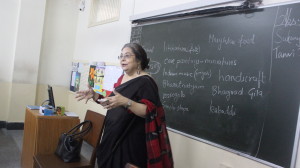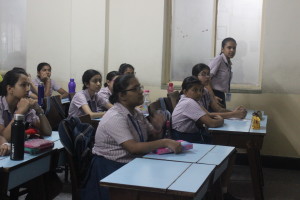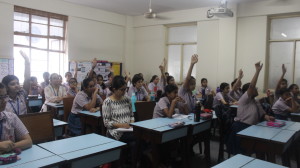‘What do you think of as Indian culture?’
‘Sari!’
‘Rosogolla!’
‘Festivals!’
‘Mughlai cuisine!’
The History for Peace Outreach Programme reached Modern High School for Girls on 26 July 2018. 40 girls from Class 8, led by Anjum Katyal (member of the History for Peace advisory board, educationist and co-director of the Apeejay Kolkata Literary Festival), explored what we mean by Indian culture. The class started off with the girls sharing what they knew about foreign colonies in India. While everybody knew about the British Empire, some of them spoke of Chandannagar being a French Colony, and others of the French-Dutch-Danish heritage of Serampore. We discussed Sir William Jones, the founder of the Asiatic Society and Sir William Carey, the British Christian missionary who brought printmaking to Bengal.
The students were then asked to share what they associated with the idea of Indian culture – they mentioned diversity, festivals such as Diwali and Durga Pujo, food such as rosogollas and Mughlai cuisine, handloom cloth, rituals, classical dance such as Bharatnatyam, among other things. The discussion went forward with Anjum explaining the myriad influences which shaped each of the elements the students believed to be signifiers of Indian culture- she explained how the rosogolla is indebted to the Portuguese tradition of splitting milk, how Durga’s ornaments came to be known as ‘daaker shaaj’ because the tinsel used in it came to Bengal via daak, post. How at one point of time women did not wear blouses with their saris because their lives revolved around their homes, and nothing more. That the blouse was only incorporated when women started taking strides into the outside world. We discussed how different rituals are practiced across the different communities in our country.
It was a highly interactive discussion which concluded with the students summing up their takeaway from the class—that what we know as Indian culture does not stand as an isolated, rigid entity, but is constantly changing with the confluence of thoughts, ideas and practices we encounter in our lives. That culture evolves over the years, reflecting the changes that have come about in society. That our identities are deeply connected with what we think of as our culture.
Ms. Sunita Biswas, their history teacher, who sat in on the session, opined that it was a very good introduction for the next segment the students will be delving into in class –that of the British empire and its impact on the subcontinent.
The second History for Peace session was held on 26 July 2018. For more details about the project, visit www.historyforpeace.pw
–Anushka Halder



